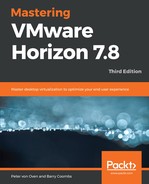These settings define the power state of the virtual desktop machines and what happens when end users connect and disconnect. The settings options are shown in the following screenshot:

You then have the following options for configuring the Remote Settings:
- The first option is for the Remote Machine Power Policy option, which defines the power state of the virtual desktop machine when users connect and disconnect. Click on the drop-down menu (19) and you will see the following options:
- Take no power action: The virtual desktop machine will remain in the last state it was left in. For example, if the desktop was left powered on, then it will remain powered on.
- Ensure machines are always powered on: The virtual desktop machines will always be restored to a powered on status after being shut down by an end user or an administrative task.
- Suspend: Virtual desktop machines will be suspended when a user logs off. Note, Suspend is not available when using NVIDIA GRID vGPU desktops.
- Power Off: Virtual desktop machines will be powered off when a user logs off.
When configuring power policies, the most important thing to do is to understand your use case and choose the correct options as appropriate. For example, if you have 200 users, all planning on logging in within a 10-minute window at 9:00 A.M., and the desktops are powered off or suspended, then this could cause some delay and a large performance spike while the desktops are resumed or powered on. Alternatively, if you are using a dedicated desktop model with a shift-based work pattern and choose to leave the desktops always powered on, this could cause your environment to be over-allocated in terms of desktop resources, as well as you potentially having more OS and software application licenses than you actually need or use.
- The next setting is for Automatically logoff after disconnect (20). This option allows you to define what happens when a user simply disconnects from their desktop and doesn't choose to log off. Click the drop-down menu to see the following available options:
- Immediately: When the user disconnects from the virtual desktop machine, it is immediately logged off.
- Never: When the user disconnects from the virtual desktop machine, it is never logged off.
- After...: When the user disconnects from the virtual desktop machine, it is logged off after a set period of time. You can choose how many minutes before the desktop will be logged off.
Again, how you configure this setting will very much depend on how your users will use the desktop. Very rarely would you choose to log off the desktop immediately in case the user has only temporarily disconnected from their desktop or has been disconnected due to a network connection glitch. You should give them at least a 5- to 10-minute window to allow them to reconnect rather than just logging them out straight away.
- The next setting to configure is the Allow users to reset/restart their machines (21) option. If this option is set to Yes, it means that the users are able to effectively use a reset button to hard reset their virtual desktop machine. This can be a useful feature to allow end users to perform troubleshooting steps without the assistance of IT. However, it can also cause some confusion when the end user believes they are simply resetting the endpoint device but instead they are resetting their virtual desktop machine. If this is a Linked Clone desktop, then they could end up with a completely new virtual desktop machine being provisioned resulting in them potentially losing any current work.
- The final setting in this section is for Refresh OS disk after logoff (22). As this pool is going to be created using Linked Clone images, this option defines how the operating system disk of the Linked Clone behaves when a user logs off.
- To configure this option, click the drop-down menu for the following available options:
- Never: The operating system disk will never be refreshed automatically; this will result in the Linked Clone growing over time, especially if a persistent disk and/or a disposable disk isn't configured in the later stages of this wizard. By refreshing the OS disk, the disk is refreshed to a snapshot that is taken when the desktop is originally created. Without a persistent disk, redirected profiles, and so on, all user settings/data will be lost.
- Always: The desktop will be refreshed every time the user logs off.
- Every...: Allows you to define the number of days after which the desktop will be refreshed.
- At...: Allows you to set at what percentage of OS disk utilization should the desktop be refreshed.
Again, as with the other configuration settings, how you configure these settings will depend greatly on your use cases and how your users work.
The next section in this configuration screen is to configure the Remote Desktop Protocol.
